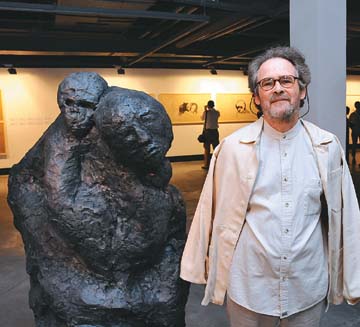|
Newman Huo

“THE landscape has come to the world/shaped by people’s steps/The Hanyang Mausoleum/as it is open/we walk inside/leave the sky behind/to pursue the paths/the paths of the memory of this land…”
This is the beginning of an 80-line French poem, “At the Hanyang Mausoleum,” written by the French painter, sculptor and poet Michel Madore after he visited the Hanyang Mausoleum in Shaanxi Province early in 2010.
Madore read this poem in French to audiences when his solo art exhibition, “Staying Alive,” opened at The OCT Art and Design Gallery in Overseas Chinese Town in Nanshan District on Saturday.
The exhibition, scheduled to run until June 28, features dozens of large ink paintings as well as five large sculptures, which the French artist created specifically for this solo exhibition in Shenzhen.
“My paintings have been inspired by my heart-touching trip to the Hanyang Mausoleum in Shaanxi Province last year, which gave me a chance to see, feel and experience the souls of old China,” said Madore.
Located in Zhanjiawan Village, about 20 kilometers north of Xi’an, the capital city of Shaanxi Province, the Hanyang Mausoleum is the tomb of the fourth emperor Liu Qi (188-141 B.C.) and his queen of the Western Han Dynasty (206 B.C.-A.D. 25). It is the most complete mausoleum from this dynasty yet discovered.
The Han Dynasty was in its heyday under the rule of Liu Qi and contributed much to the social and economic development of ancient China. The mausoleum was built in 153 B.C. when the emperor was still alive. When the empress died in 126 B.C., she was also buried in the mausoleum.
Tens of thousands of relics, including colored nude terra-cotta figurines and a variety of animals, have been unearthed in the mausoleum since the 1970s.
After his visit to the mausoleum, Madore spent some quiet time leisurely preparing his paintings at his studio in the suburbs of Paris, while meditating on the ancient Chinese people he saw in the ancient mausoleum and wishing them back to life in his works.
Most of Madore’s paintings have been done with a combination of Western sketching and Chinese ink lines and wander between the souls of silence, beauty and unrest. His works present void, poetry, Zen-like thinking and expressions, all in plain, unique free-style.
Madore integrates freehand brushwork and expression, together with the Chinese aesthetic of simplicity and Western sublimity, to create ink figures with distinctive charm.
Figures in his paintings reveal his understanding of void and quietness, elegance and profound thinking.
Madore was born in Montreal, Canada in 1949. He has lived and worked in Paris since 1977. A self-educated artist, Madore has presented his works in nearly 200 solo and group exhibitions in museums, galleries, cathedrals, libraries and cultural centers in Canada, France, Luxembourg, Belgium, Germany, the Netherlands, Hungary, Portugal, Algeria, Bosnia and South Korea.
Over the past decade, he has been exhibiting in Beijing, Shanghai, Guangzhou, Wuhan and Xi’an and considers his work to be “a bridge to communicate with Chinese people today.”
A major event of the 2011 Sino-French Cultural Spring, the exhibition was organized by the French embassy in China and the French consulate in Guangzhou. It has won special support from the French Institute as well as sponsorship from the French company Electricite De France.
Dates: Until June 28
Hours: 10 a.m.-5:30 p.m. Closed Monday
Add: The OCT Art & Design Gallery, Overseas Chinese Town (深圳华侨城华·美术馆)
Metro: Hua Qiao Cheng Station (Overseas Chinese Town Station 华侨城站), Exit C
|

